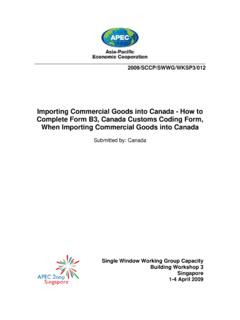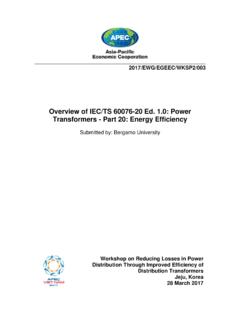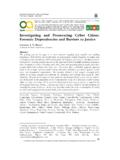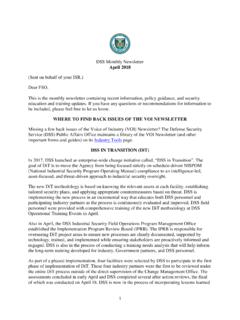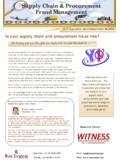Transcription of Handbook (First Part) - Best Practices in …
1 _____ 2014/SOM1/ACT/012 Agenda Item: 10 Handbook (First Part) - Best Practices in investigating and prosecuting corruption using Financial Flow Tracking Techniques and Financial intelligence Purpose: Information Submitted by: Chile 18th Anti- corruption and Transparency Experts Working Group MeetingNingbo, China20 February 2014 Best Practices in investigating and prosecuting corruption using Financial Flow Tracking Techniques and Financial intelligence A Handbook First Part APEC Anticorruption and Transparency Working Group (ACTWG) November 2013 1 TABLE OF CONTENTS PRESENTATION .. 3 CHAPTER I: PRE-CONDTIONS FOR COMPLEX INVESTIGATIONS .. 5 A. ENSURING ADEQUATE RESOURCES .. 6 B. BUILDING AN INVESTIGATION TEAM .. 6 1. Team selection .. 6 2. Team training .. 7 3. Engaging specialized experts.
2 8 C. IDENTIFYING POTENTIAL TARGETS .. 9 D. DEVELOPING AN INVESTIGATIVE STRATEGY .. 10 1. Case selection strategies .. 10 2. Case management .. 12 E. CHOOSING INVESTIGATIVE METHODS AND TECHNIQUES .. 14 1. Standard investigative techniques .. 14 2. Special investigative techniques .. 15 CHAPTER II. BUILDING COORDINATION AND COOPERATION NETWORKS .. 18 A. INTERNAL COOPERATION AND COORDINATION ISSUES .. 18 B. COLLABORATION BETWEEN LAW ENFORCEMENT AGENCIES AND FIUS .. 20 1. Accessibility of FIU disclosures in financial investigations .. 22 2. Proactive sharing of information between the FIU and investigating authorities .. 23 3. Use of FIU s intelligence as evidence .. 24 4. Ensuring the proper use of data .. 24 C. INTERNATIONAL COOPERATION IN THE INVESTIGATION .. 25 1. Informal cooperation networks .. 26 a. Personal connections .. 28 b. The International Criminal Police Organization (Interpol).
3 29 c. The Egmont Group .. 29 2. Formal cooperation .. 30 CHAPTER III. THE GATHERING OF PERIFHERAL EVIDENCE .. 32 A. SOURCES OF INFORMATION .. 36 B. GATHERING PERIPHERAL EVIDENCE .. 39 1. Open Sources .. 40 a. General aspects .. 40 b. Search Engines and the Deep, or Invisible Web .. 44 c. Social Media .. 47 i. Social Media Monitoring Tools .. 49 ii. Compromise Issues & Internet Footprints .. 50 iii. Storage of data and gathering of evidence .. 50 iv. Privacy and other precautions .. 51 2. Government agencies databases (publicly and not-publicly available) .. 52 CHAPTER IV: THE GATHERING OF PRIVATE DIGITAL SOURCES OF EVIDENCE .. 58 A. BEST Practices FOR HANDLING DIGITAL EVIDENCE .. 62 1. Collection and preservation of digital evidence .. 62 2. Acquisition of digital evidence .. 74 B. SINGLE TYPES OF DIGITAL EVIDENCE .. 79 1. Hash Values .. 79 2. Metadata.
4 79 3. Email .. 80 4. Cell phones and Cellular Systems .. 82 5. Accounting software .. 83 C. DIGITAL FORENSIC TOOLS .. 83 2 CHAPTER V. HUMAN intelligence ..80 A. SUSPECT PROFILING .. 86 B. INFORMANTS AND 89 REFERENCES .. 93 3 PRESENTATION The following pages constitute the first part of a Handbook that will be completed and published by 2015. This Handbook was elaborated under the scope of APEC project M SCE 01 12A-1: Capacity Building Workshops on Designing Best Models on prosecuting corruption and Money Laundering Cases using Financial Flow Tracking Techniques and Investigative intelligence for Effective Conviction and Asset Recovery to Promote Regional Economic Integration .1 The project was borne within the APEC Anticorruption and Transparency Working Group (ACTWG), from joined efforts made by Chile and Thailand to improve corruption and money laundering investigation and prosecution.
5 Both economies, members of the APEC ACTWG, will be leading the project under the Multi Year Project APEC Guidelines, through 2013 to 2015. This multi-year effort has been designed in two subsequent stages. The first one, led by Chile, consisted in the revision of the legislative and regulatory framework of investigating and prosecuting corruption and the laundering of its proceeds of 10 APEC economies: Australia; Canada; Chile; Indonesia; Hong Kong, China; Malaysia; Mexico; Peru; The Russian Federation; and The United States. Those economies with the exception of Canada , plus Brunei Darussalam; Chinese Taipei; The Republic of the Philippines; and Viet Nam participated in a three-day workshop Designing Best Models on prosecuting corruption and Money Laundering Cases using Financial Flow Tracking Techniques and Investigative intelligence for Effective Conviction and Asset Recovery to Promote Regional Economic Integration , that took place in Santiago de Chile from June 11 to June 13, 2013.
6 During the workshop, the economies presented and discussed their best Practices for investigating and prosecuting corruption and the laundering of its proceeds. The proposed objectives of the workshop were to focus the presentations on financial investigation techniques and on the use of digital forensics for uncovering corruption . The presentations, however, also brought to the table other important issues in investigating corruption , such as the essential elements of building of an investigation plan and strategy and the best Practices related to building coordination mechanisms and cooperative networks both domestic and internationally. The following pages capture the knowledge gained from the workshop, including the content of the presentations and discussions developed therein.
7 4 We start by introducing the basics of any investigation: how to develop a plan, how to organize the resources, identify potential targets, define the scope of the investigation and select the techniques that will be used to potentially prove the allegations (Chapter I). Chapter II focuses on issues of coordination, both domestic and international, and in the related aspect of building cooperative networks. We review the best Practices for domestic cooperation, taking into account the internationally recognized Practices for sharing information, especially financial information. In light of the workshop discussions, we specifically revisited the coordination between FIUs and other law enforcement agencies. While Chapter III focuses on the gathering of peripheral evidence, through open sources techniques, databases searches, and digital forensics tools, Chapter IV explains the gathering of private sources of evidence, including the use of digital forensic tools.
8 Chapter V closes this first part of the Handbook , with a practical approach on how to perform human intelligence , specifically the technique of profiling suspects. The second part of the Handbook is envisaged as, on the one hand, completing the evidence gathering chapters, mainly by focusing on the gathering of financial evidence. On the other hand, it is suggested that the second part of the Handbook develop three chapters devoted to the asset recovery process: restraining measures, confiscation proceedings and repatriation issues. This second part will be built through a similar process than the first part: in 2014, led by Thailand, a workshop to share best Practices in financial evidence and asset recovery best Practices will serve as a basis for writing those remaining chapters.
9 5 CHAPTER I: PRE-CONDITIONS FOR CONDUCTING COMPLEX INVESTIGATIONS Investigations of corruption are often very complex, since they usually involve a multitude of relevant actors and targets, movement of assets and financial vehicles used or placed in overseas jurisdictions. Successful investigations of complex corruption schemes are not only the result of dedicated individual efforts but also the consequence of some institutional pre-requisites, which provides an adequate environment for such a success to take place. This introductory Chapter is devoted to remind the essential pre-conditions that any competent authority needs to envisage as the ideal grounds for ensuring the success of complex investigations and, to the extent of its responsibilities, help to build the institutional capacities towards its fulfillment.
10 The primary objectives of an investigation are: Evidence gathering Fact finding and reconstruction Reporting to / supporting conclusions of the competent authorities. The investigative team s main responsibility is to bring facts to life for prosecutors, judges and other competent authorities with decision-making capacities. Investigations should be capable of providing grounds to both criminal prosecutions and to the reorganization of public or private administrations with the purpose of preventing the same facts from happening again. The first step of an effective investigation is its planning. Investigators should begin by identifying the standards, rules, and procedures that govern the circumstances under investigation and the information already available. They must determine what additional information will be required before findings and recommendations may be made to the competent authority, and therefore should elaborate an understanding of the steps which are required to obtain the necessary evidence, including, among others, a list of potential sources of information and specific strategies for witnesses interviewing, in order to reach a conclusion on the merits.


